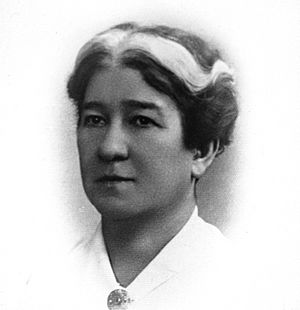Nathalie Zand facts for kids
Quick facts for kids
Nathalie Zylberlast-Zand
|
|
|---|---|
 |
|
| Born |
Nathalie Zylberlast
28 March 1883 Warsaw, Poland
|
| Died | 23 or 24 September 1942 Pawiak prison, Warsaw
|
| Nationality | Polish |
| Other names | Nathalie Zylberlast-Zandowa. |
| Alma mater | University of Geneva |
| Occupation | Neurologist |
Nathalie Zylberlast-Zand (born 1883 – died 1942) was a Polish Jewish doctor. She was a neurologist, which means she studied the brain and nervous system. Nathalie Zylberlast-Zand died in a Nazi prison during World War II. She also published her research using the name Nathalie Zylberlast-Zandowa.
Contents
Her Life Story
Nathalie Zylberlast-Zand was born in Warsaw, Poland, on March 28, 1883. Her parents were David Zylberlast and Emilia (née Batawia).
Her Education
In 1899, Nathalie finished high school in Warsaw. She then went to the University of Geneva to study medicine. She earned her medical diploma there. Her main project was about a type of blood cancer in a baby.
Later that same year, she passed another important exam. This exam was at the National University of Kharkiv in Ukraine.
Her Work as a Doctor
Nathalie Zylberlast-Zand was a dedicated researcher. She often wrote articles for French medical magazines. She worked closely with Edward Flatau, who was a very important person in modern neurology.
She worked at the Jewish Hospital in the Czyste area of Warsaw. This hospital helped many people in the community.
Nathalie was married to Maksymilian Zand. He was a businessman and also worked to help people in society.
Life During World War II
During World War II, Nazi Germany took over Warsaw. Nathalie, like many other Jewish people, was forced to live in the Warsaw Ghetto. This was a special area of the city with walls around it.
Even in the ghetto, she continued to work as a doctor. On September 23 or 24, 1942, she was taken to the Pawiak prison in Warsaw. It is believed she was killed there. She is remembered as one of the many Jewish doctors from Poland who died during the war.
Her Scientific Discoveries
For many years, Nathalie Zylberlast-Zand worked with Edward Flatau. She was his assistant in his brain research lab at the Jewish Hospital in Warsaw.
Brain Research
Nathalie Zylberlast-Zand studied many parts of the brain. She researched how the brain works and what happens when it gets sick. Some of her studies looked at comas and different parts of the brain like the choroid plexus.
She found that meningitis, a brain infection, acts differently in patients who also have tuberculosis. In 1921, she and Flatau wrote about how the brain reacts to tuberculosis.
Important Books and Discoveries
In 1930, she wrote a book called Les plexus choroïdes. This book was all about the choroid plexus, a special part of the brain. A famous brain doctor, Gustave Roussy, wrote the introduction for her book.
Nathalie Zylberlast-Zand was also the first to describe something called the "oculo-finger reflex." She noticed this reflex in people who had Parkinson's disease after being in a coma.

